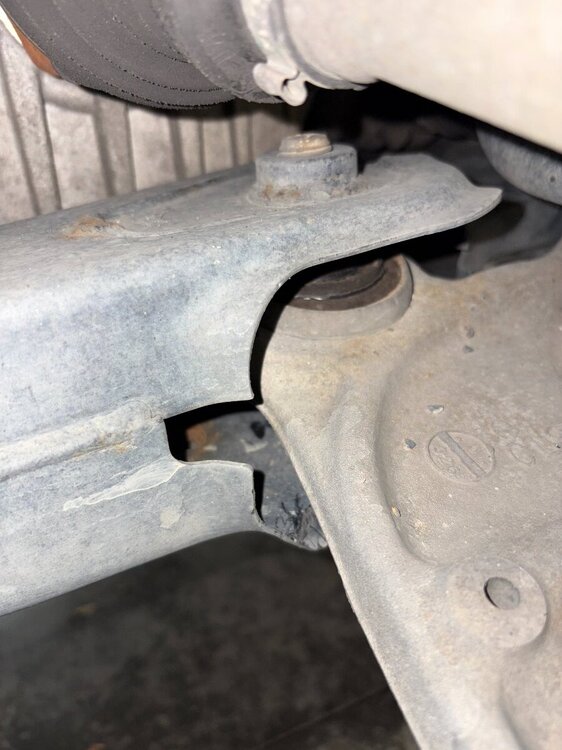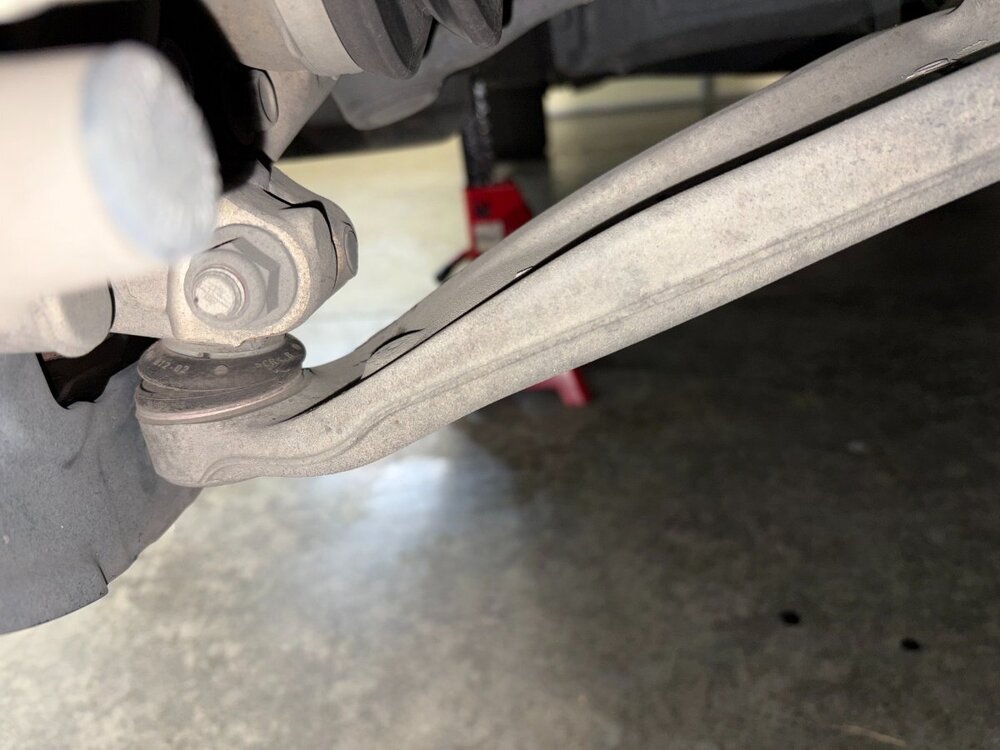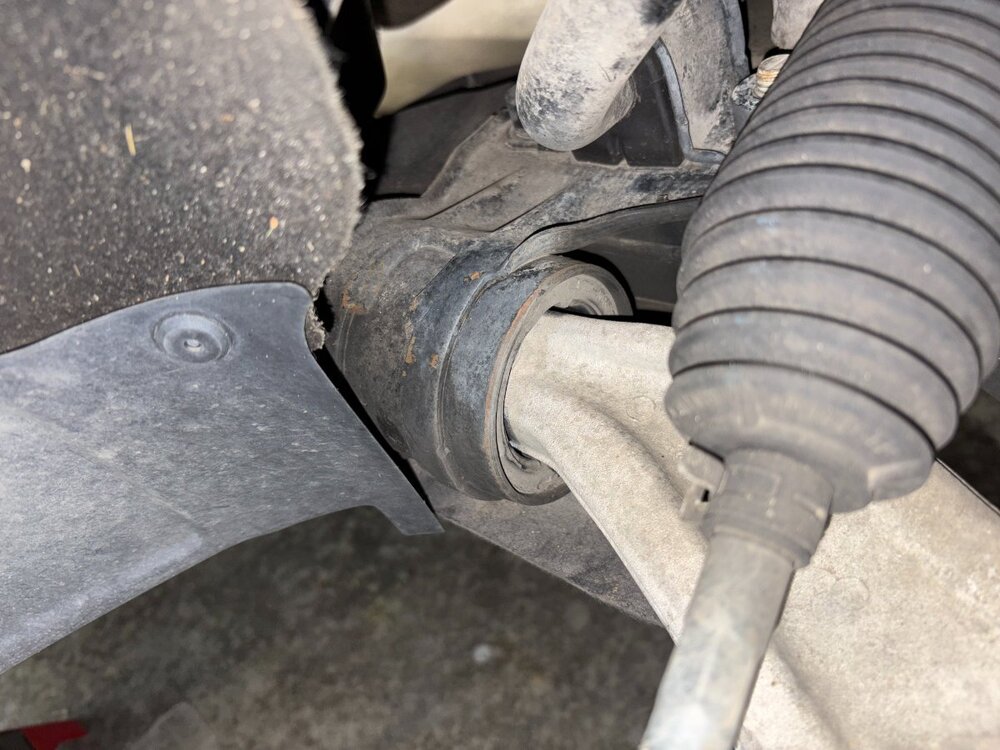All Activity
- Yesterday
-
I need to purchase a set of winter for my car, and very likely need the TPMs. Has anyone used any TPMs I can get from Amazon and relearn it properly? I am asking it becasue this is the first time I am trying to purchase from Amazon.
-
That was my suspicion as well. I’ll dig through the trash and find it. One of the benefits of having a kid accidentally not take the trash to the curb.
-
Do you suspect this is related to the serpentine belt? Best buy an OBDII dongle and use the free app Forscan Lite to read and reset the codes - Autozone can also do this free of charge. What's the coolant temp gauge showing? If the coolant issue is unresolved, you won't be able to reset the code.
-
Any chance you could post a photo of the bad coil? If it burnt up, I'd suspect that the spark plug isn't seated properly and leaking hot combustion gas.
-
I accidentally mentioned injector. I meant coil pack. I have no idea why the coil pack went bad and I have no indication on what would have caused it other than the P0430 code, which, as I said, doesn’t make sense to me given the lambda and O2 sensor readings. All purchases were through rock auto.
-
Welcome. I would focus on the cause of the failed fairly new coil pack. You talk of the coil pack and then mention the injector - I'm guessing it's not direct injection but puzzled by the mention of the injector. Where were these purchased? - many counterfeit versions of these on the market.
-
nolahusker started following Permanent Catalytic Converter P0430 Code
-
I am new to this forum and did some searching but haven’t found a topic on this. It may be that my Google-fu is weak, but, if so, maybe someone can point me to the right thing. Anyhow, I am getting a permanent engine code of P0430 on my 2013 Edge Limited (3.5L). My OBD2 reader (Innova 5210) is telling me this is a catalyst system efficiency issue on Bank 2. I, for the life of me, can’t figure out why I would have this. Some background: Last year, I replaced all the injectors, plugs, and coil packs and the catalytic converters. I did this because I had a couple coil packs fail on me and an injector going out, plus a catalytic system efficiency code. This was about 20,000 miles ago. The vehicle has 197k miles as of today. I did use aftermarket catalytic converters off Rock Auto (Original Performance models OPCF5071 and OPCF5072), Bosch injectors, and Motorcraft coil packs. I started getting the P0430 code about 2 weeks ago, then got a coil pack code and misfire code for cylinder 6 a few days ago. I pulled the coil pack for 6 and it was physically toast (shaft of the injector was swollen and cracked). Replaced the coil pack and the plug, cleared codes, and everything ran just fine. No new codes. My wife was driving and had the check engine light pop on and I’m getting the P0430 code again (see below). I used the OBD2 reader to plot performance of the O2 sensors and converters as shown below. I’m not seeing anything in particular that’s making me think I have an issue. Anyone ever run across this before? I don’t want to damage my new(er) injectors, coil packs, and plugs, but I will replace anything as needed. Any insight anyone can provide would be helpful. The vehicle drives just fine and I drove it at 78 mph on cruise control for about 70 miles today. I’m just concerned about damaging other components if I have a bad converter. As far as I can tell, the sensor readings are all normal. Codes: I had 9 codes after changing the coil pack, including one about saturated O2 sensors (forgot to write it down), but I cleared them, drove around today, and still have these: 1/3: P0430 (Permanent) - Catalyst system efficiency below threshold (Bank 2) DTC Severity 2 of 3. Repair immediately if drivability issues are present. Threat to essential system components if not repaired as soon as possible. 2/3: P0430 (Pending) - Catalyst system efficiency below threshold (Bank 2) 3/3: P0430 (Permanent) - Catalyst system efficiency below threshold (Bank 2) Live data (max and min from graphing while driving): O2 Sensor B1S2: 0.055 - 0.85V O2 Sensor B2S2: 0.045- 0.85V O2 Sensor B1S1: -0.14 - 0.05 mA O2 Sensor B2S1: -0.05 - 0.24 mA STFT B1S2: 99.2% STFT B2S2: 99.2% B1S1 Lambda: 0.995 - 1.009 B2S1 Lambda: 0.950 - 1.027 Note: both go to 1.999 when coasting at highway speed. Cat Temp B1: 925 -1520F Cat Temp B2: 923 -1520F
-
Randyman joined the community
- Last week
-
Per-Even Halstvedt joined the community
-
Jason499 joined the community
-
Does anyone know how to reset a limp mode alarm in a Ford 2019 edge ST with a 2.7 L engine. I have: engine coolant over temp. And it will not go away. Is there a way to reset this without a scanner? I did have a previous problem, but it has been repaired. Thanks, Jason
-
A5ust joined the community
-
i have a 2013 ford edge with custom headers k&n intake and a street tune stock the car was pushing 305hp im now at 497 after the dyno test my street tune gave me 60+hp with burbles and pops and bangs rev limiter deleted aswell as speed limiter
-
paul43 joined the community
-

Shimmy, shake, jiggle, when >50 mph and accelarating
1004ron replied to 1004ron's topic in All Wheel Drive (AWD)
New control arm was delivered this afternoon and its installed. Examining the old control arm bushes and ball-joint I'd say its in perfect serviceable condition. The job is a real challenge and my advice is don't tackle this on your own in your garage - at least have a friend work with you and better still have a shop lift. The bolts were SUPER tight - had to use a makeshift extension to my long breaker bar. It is really difficult to get the bushes engaged and the ball joint. The drive shaft popped out and spilt a little more than half a quart - I just let it dribble into an oil pan while I manipulated the control arm into place. Tomorrow I'll take it for a drive to get the tans temps up and then top up the fluid - not expecting any change to the shimmy shake, but if it has resolved it I'll be very happy. Now I'm thinking possibly the strut bearing? -
stu11926 joined the community
-
Moral of the story often repeated, Never open the pano roof and never encounter a problem.
-

Shimmy, shake, jiggle, when >50 mph and accelarating
1004ron replied to 1004ron's topic in All Wheel Drive (AWD)
New original equipment tires, Pirelli installed on Monday at Costco - no change in the shimmy shake, but significantly quieter than the Bridgestone that were on. -

Shimmy, shake, jiggle, when >50 mph and accelarating
1004ron replied to 1004ron's topic in All Wheel Drive (AWD)
Recently occasionally when I back out my garage then turn the wheel full lock to the right to move down my driveway I've heard and felt a soft knock on the left front. I have all my wrenching life avoiding the use of the "Parts Cannon", but that's about to change. I suspected the left lower control arm bushes or ball joint so a couple of days ago I took a closer look at them, also used a pry bar to see if I could invoke some movement, but none - the inspection method used is flawed in that the control arm is in a taught position with the suspension fully extended. I've ordered a new Fomoco control arm for $213 delivered, that might arrive in time for installation this weekend or it'll be the next weekend. -
Oldandintheway started following Comprehensive List of Possible Forscan Mods?
-
Just recently, I went to open the shade for my sunroof (2019 Edge ST) and near the end of travel, it sounded like gears stripping, etc. I just took it in to the local Ford dealer (Stillwell Ford in Hillsdale, MI) and they gave me an estimate of $1800 (OUCH!) I declined obviously, so I wanted to ask if that is a known issue and maybe get pointed to some repair it yourself videos. I am capable, having been a mechanic/engineer for over fifty years. Thanks very much. (Love the car, lament that I got the panaorama roof) RPG
- 1 reply
-
- 2
-

-
He cracks me up with the props - good information there - something I have long suspected now backed up with data.
-
First off, I would put aside the RCM / BECMB DTC and focus on the parasitic power draw. It is likely that the RCM or BECM-B are the cause of the battery drain, but you should complete a parasitic battery drain test to confirm and find the issue. Parasitic Battery Drain Job Aid.pdf Airbag and Seatbelt Pretensioner Supplemental Restraint System (SRS) - Overview The RCM continually receives and monitors inputs from the OCSM, BECMB and various other hard-wired switches and sensors. If the RCM detects a sudden vehicle deceleration and/or lateral deceleration based on the information received from the various sensors, and determines that deployment is necessary, the RCM applies voltage and current to deploy the appropriate SRS components. Extended Power Module [BECMB] The BECMB provides system voltage to the RCM and OCSM when the ignition is ON. Additionally, the BECMB is designed to ensure that the RCM and OCSM remain powered on if the ignition is turned off while the vehicle is moving at a speed greater than 4 km/h (2.5 mph). If the ignition signal is active / high while the vehicle is travelling at a speed above 4 km/h the BECMB maintains system voltage on the RCM and OCSM power supply circuits. If the ignition signal is lost, missing, or below a certain threshold while the vehicle is travelling at a speed above 4 km/h (2.5 mph), the BECMB maintains system voltage on the RCM and OCSM power supply circuits and a telltale appears in the IPC. If the vehicle speed rises above the threshold again, the BECMB does not reactivate the power supply to the RCM and OCSM. They remain off until the ignition is turned on again. If a vehicle is parked, with the ignition off, the BECMB does not provide power to the RCM and OCSM. If the vehicle begins to move, while the ignition is still off, the BECMB does not power the RCM or OCSM. When the vehicle has been started using the remote start feature (if equipped), the ignition status is off, but the BECMB powers the RCM in order to detect a collision and disable the fuel pump, if necessary The BECMB supplies system voltage to the RCM and OCSM, based on HS-CAN1 inputs and the ignition input. The BECMB requires PMI when being replaced. Refer to the diagnostic scan tool instructions to carry out PMI. Supplemental Restraint System (SRS) Depowering WARNING: Incorrect repair techniques or actions can cause an accidental Supplemental Restraint System (SRS) deployment. Never compromise or depart from these instructions. Failure to precisely follow all instructions could result in serious personal injury from an accidental deployment. WARNING: Incorrect repair techniques or actions can cause an accidental Supplemental Restraint System (SRS) deployment. Never compromise or depart from these instructions. Failure to precisely follow all instructions could result in serious personal injury from an accidental deployment. Determine if a SRS fault is present. Turn the ignition OFF and wait 10 seconds, then turn the ignition ON and monitor the airbag warning indicator. The airbag warning indicator illuminates continuously for approximately 6 seconds and then turns off. Continue to monitor the airbag warning indicator for approximately 30 seconds as this is the time required for the RCM to complete testing of the SRS. If a SRS fault is present the airbag warning indicator either fails to light, remains lit continuously or flashes. The flashing may not occur until approximately 30 seconds after the ignition has been turned from OFF to ON. If this occurs, diagnose and repair any SRS faults before proceeding with other repairs. If after the ignition has been turned ON for 30 seconds the airbag warning indicator remains unlit with no chime or SRS message displayed in the message center, no SRS fault is present. If the airbag warning indicator is inoperative and a SRS fault exists, a chime sounds in a pattern of 5 sets of 5 beeps or a message displays in the message center. If this occurs, diagnose and repair the airbag warning indicator and any SRS faults before proceeding with other repairs. No SRS Fault Present (with ignition ON, airbag warning indicator stays off after prove out) WARNING: Turn the ignition OFF and wait one minute to deplete the backup power supply. Ignition must remain OFF until repair is complete. Failure to follow this instruction may result in serious personal injury or death in the event of an accidental deployment. Turn the ignition OFF and wait one minute before continuing vehicle service. SRS Fault Present Turn the ignition OFF. Remove the RCM fuse or if equipped, BECMB fuse(s). For a vehicle equipped with a 3 blade BECMB/ GWM fuse, install a 2 blade 10A fuse at the GWM position to allow the scan tool to communicate with the vehicle network. Turn the ignition ON. Using a diagnostic scan tool, carry out a Network Test. Verify that the RCM and, if equipped, BECMB does not respond to the Network Test. If the RCM or BECMB pass the Network Test, remove the correct RCM or BECMB fuse and repeat the Network Test to verify before proceeding. Turn the ignition OFF. Disconnect the battery. Wait at least one minute before continuing vehicle service. BECMB Installation To install, reverse the removal procedure. Repower the SRS. For a new BECMB, do not prove out the SRS at this time. Refer to: Supplemental Restraint System (SRS) Repowering. NOTE: This step is only necessary when installing a new BECMB. Using a diagnostic scan tool, complete the PMI process for the BECMB following the on-screen instructions. If a new BECMB was installed, prove out the SRS as follows: Turn the ignition from ON to OFF. Wait 10 seconds, then turn the ignition back to ON and monitor the airbag warning indicator with the airbag modules installed. The airbag warning indicator illuminates continuously for approximately 6 seconds and then turns off. If a SRS fault is present, the airbag warning indicator either fails to light, remains lit continuously or flashes. The flashing might not occur until approximately 30 seconds after the ignition has been turned from OFF to ON. This is the time required for the RCM to complete the testing of the SRS. If the airbag warning indicator is inoperative and a SRS fault exists, a chime sounds in a pattern of 5 sets of 5 beeps. If this occurs, diagnose and repair the airbag warning indicator and any SRS faults. Electrically, the BECMB is located on the HS1-CAN network. It is physically located somewhere nearby the RCM, underneath the center floor console. The BECMB requires PMI when being replaced. Refer to the diagnostic scan tool instructions to carry out PMI. This means that the AsBuilt data of your BECMB will need to get copied over from the old one to the new one. Yes. Ensure you properly power down and power on the SRS system to safely work on it. Remember your health and safety. You need to have the skills to troubleshoot the electrical issues and work safely. You can use FORScan to program the new module if it gets replaced. You also must remember the importance of your health an safety.
-

Transmission fluid drops on the floor
1004ron replied to Brockdog12's topic in Dealership & Vendor Experiences
Congrats. From the same dealer and with the same maintenance package serviced by them? -

Transmission fluid drops on the floor
Brockdog12 replied to Brockdog12's topic in Dealership & Vendor Experiences
Took the Edge in, dealer admitted to over filling the transmission and cleaned all parts covered in tranny fluid, had the oil changed and wipers changed out also, then I traded it in Saturday for an Explorer. -
I remember some Mfg.s had an indicator to let one know when to service the filter.
-
Long story short... airbag light came on 3 weeks ago, then the battery died within 2 days. It was an old battery so I bought a new one and dropped it in, and did the 5x headlights 3x brake 'trick' to reset things, assuming that was sufficient. This week, the airbag light came on again, but this time, the new battery died yesterday. I jumped it, ran it for quite some time. I hadn't bothered to check codes before this, so I grabbed my OBD2 cable & started up Forscan. There were a number of codes, but only one present at the time of request. I figure the others came up due to the battery dying. So I reset the DTCs and just one code continues to come up: U0413 Invalid Data Received from Battery Energy Control Module 'B' (from the RCM) It seems like the BECM 'B' is busted and drawing current when the vehicle is off, because... I also used Forscan to check the Battery State of Charge last night, and it was 99%. 8 hours later: 70%. I ran the vehicle for about an hour or so and it was back up in the 90s. I searched U0413 and found one other thread on this forum, but that person also had a bunch of other errors and their issue seemed to be the RCM itself. The BECM 'B' module looks to be PN HU5T-14G490-AF or HU5T-14G490-0C and it's like $70 new or $35 if I take the eBay plunge. So, the questions I have for the other owners here, are... Do you think my BECM 'B' is the root cause? Or is it failing because of something else (like a short? ugh... I hope it's not a short...) Where is the BECM 'B' located, exactly? I'm cool with tearing some things apart to get to it, but I don't know where to find it... Is the BECM 'B' a plug & play / drop & replace type of part, or does it need very specific programming for my specific make/model/VIN/etc.? Since the RCM is shooting the BECM 'B' communication error, should I be worried about the RCM/airbags/SRS? Am I stuck with needing to take this to a dealer? Thanks in advance for any suggestions or insight!
- 1 reply
-
- 1
-

-
The free flow air filters obviously allow more damaging particulate to pass through which is the most significant factor for me, but many are misled by the claims of increased power. There are other components that dictate the maximum air the engine can ingest.
-

2015 edge sport dead but battery test good
1004ron replied to roedge's topic in Alarms, Keyless Entry, Locks & Remote Start
Welcome. 14.8v seems a little high. When you replaced the battery did you reset the BMS (Battery Monitoring System)? It could also be a parasitic drain - do a search for that and you'll find a few good YouTube videos on how. Places like AutoZone have testers that check the CCA, Cranking Voltage, and Charge rates - have them do that. -
Wanting to spend a few hundred dollars wisely? Drive through the poor section of your town and drop 30 $10 dollar bills out the window or, pick an Angel off the Christmas Tree @ the mall. Watch the video before you spend your hard earned $$$$!
-
Anyone have this problem? I just put a new battery in about 3 weeks ago. Wife called yesterday and was stuck at a QT. Said car was dead. Got there and like before when I replaced battery there were no dash lights or interior lights. So I jumped the car and it started just fine. I then drove it home (20 mi) and turned car off. Then decided to go to auto zone and have alternator tested. Turned car of there and they did a battery test (not sure kid who tested it got good connection since he was having problems with meter) and it tested bad. So I pulled battery and took it back to Costco to have it tested to get another battery. It tested as 12.2 volts and 860 CCA available on a 660 CCA battery. This morning started car and everything good. Stuck a volt meter on battery before start and it was 12.2 volts then started car and it read 14.8 volts, so don’t think it’s the alternator. Any ideas were to check next. This seems to be very intermittent.







